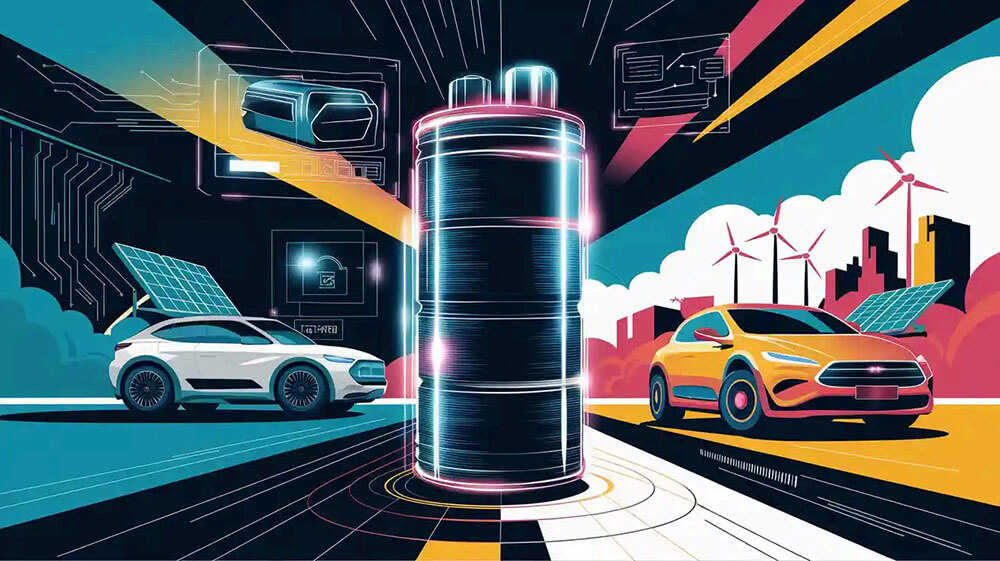Contents

Lithium battery technology has revolutionized the way industries operate, driving advancements in energy storage and powering critical applications. From medical devices to robotics, and infrastructure, its impact is undeniable. The global lithium-ion battery market is projected to grow at a CAGR of 9.43%, reaching $119.17 billion by 2030. This surge highlights its role in fostering innovations lithium battery solutions for a sustainable future.
Key Takeaways
Lithium batteries are getting better quickly, storing more energy. This makes them work well in medical tools, robots, and electric cars.
New safety features make lithium batteries safer to use. They lower the chance of overheating and are reliable for healthcare and security.
New ideas like solid-state batteries and recycling are improving lithium batteries. These changes help the environment and make batteries work better in many areas.

Part 1: Recent Advancements in Lithium Battery Technology
1.1 Enhancements in Energy Density and Performance
The continuous improvement in energy density has revolutionized lithium-ion battery technology, enabling more efficient energy storage solutions. Over the past decade, energy density has increased by 5-8% annually, with some cutting-edge designs achieving remarkable milestones. For instance, researchers have developed pouch-type lithium batteries with an energy density exceeding 700 Wh/kg. Solid-state batteries, a promising innovation, are projected to reach energy densities between 500-700 Wh/kg, while lithium-sulfur batteries offer a range of 400-600 Wh/kg with a theoretical capacity of 2500 Wh/kg. These advancements significantly enhance battery performance, making them ideal for applications in medical devices, robotics, and electric transport.
Note: Replacing traditional graphite anodes with silicon anodes could further boost energy density by 20-40%, potentially reaching 400 Wh/kg. This improvement is critical for industries requiring high-performance batteries, such as infrastructure and industrial sectors.
These technological advancements not only improve energy capacity but also support the future of lithium batteries in diverse industrial applications.
1.2 Advances in Safety Features and Thermal Stability
Safety remains a top priority in lithium battery technology, especially for industries like security systems and consumer electronics. Recent innovations have significantly enhanced thermal stability and reduced risks associated with thermal runaway. The integration of a safety reinforced layer (SRL) in lithium-ion batteries has proven effective. Studies show that applying SRL to 3.4-Ah pouch cells reduced battery explosions from 63% to just 10%. This layer interrupts current flow during voltage drops or overheating, ensuring operational safety without compromising performance.
Tip: These safety advancements are particularly beneficial for critical applications in medical devices and robotics, where reliability is paramount.
Additional measures, such as advanced electrolyte formulations and improved separator materials, further enhance thermal stability. These innovations ensure that lithium-ion batteries can operate safely under extreme conditions, making them suitable for demanding environments like industrial automation and electric vehicles.
1.3 Faster Charging and Extended Lifespan
The demand for faster charging and longer-lasting batteries has driven significant progress in lithium-ion battery technology. Researchers at the National Renewable Energy Laboratory (NREL) have developed electrochemical models that optimize battery designs, enabling extreme fast charging capabilities. These advancements aim to achieve an 80% charge in under 15 minutes, a critical milestone for electric vehicles and other time-sensitive applications.
Key Insight: Active cell balancing methods have emerged as a game-changer. By equalizing the state of charge (SOC) across cells, these methods enhance both charging and discharging capacities, thereby extending battery lifespan.
Machine learning models, such as k-nearest neighbors and random forest algorithms, now predict battery lifespan with remarkable accuracy (R2 values above 0.996). This predictive capability allows for proactive battery management, ensuring optimal performance and longevity. The XCEL program, for example, focuses on achieving a lifespan of 1000 cycles over 15 years through improved electrolyte transport and thermal management.
Unsurprisingly, these advancements have made lithium-ion batteries indispensable for energy storage solutions in infrastructure projects and industrial applications. They also play a pivotal role in the future of lithium batteries, supporting sustainable energy storage and reducing downtime for businesses.

Part 2: Emerging Trends in Lithium Battery Technology
2.1 Solid-State Batteries: A Game-Changer for the Future
Solid-State Batteries are revolutionizing the future of lithium battery technology. These batteries replace the liquid electrolyte found in traditional lithium-ion batteries with a solid electrolyte, offering significant advantages in energy density, safety, and longevity. According to market projections, the solid-state battery industry is expected to grow at a CAGR of 34%, becoming a multi-billion-dollar market by 2030. By then, 10-15% of electric vehicles are anticipated to adopt this technology.
Statistic | Value |
|---|---|
Energy Density Increase | 2-3x over lithium-ion |
Charging Speed | 60-80% in 15 minutes |
Longevity | 2-5x longer lifespan |
Safety | 90% reduction in thermal risks |
Weight Reduction | 30-40% lighter than lithium-ion |
These advancements make solid-state batteries ideal for high-performance batteries in electric transport and industrial applications. For instance, their ability to store twice as much energy as conventional lithium-ion batteries addresses range concerns for electric vehicles. Additionally, their enhanced safety profile, with a 90% reduction in thermal runaway risks, ensures reliability in critical applications like medical devices and robotics. The expected cost of solid-state batteries by 2030, ranging between $80-90/kWh, further highlights their potential for affordability compared to current lithium-ion costs.
Tip: As the demand for sustainable energy storage grows, integrating solid-state batteries into your energy storage solutions can provide a competitive edge. Explore custom battery solutions tailored to your needs with Large Power.
2.2 Recycling Innovations for Sustainable Battery Solutions
The rapid growth of lithium battery technology has intensified the need for sustainable practices. Recycling innovations are emerging as a critical solution to address environmental concerns and material scarcity. Advanced recycling technologies now enable the recovery of valuable materials like lithium, cobalt, and nickel, reducing dependency on raw material mining. This aligns with global efforts to promote sustainable energy storage.
Key advancements in recycling include:
Transitioning to closed-loop systems that recover up to 95% of battery materials.
Developing hydrometallurgical processes for efficient material extraction.
Implementing AI-driven sorting systems to enhance recycling efficiency.
These innovations not only minimize environmental impact but also contribute to cost savings for industries relying on lithium-ion batteries. For example, recovered materials can be reused in manufacturing new batteries, reducing production costs and ensuring a steady supply chain. Industries like infrastructure and consumer electronics stand to benefit significantly from these advancements, as they rely heavily on energy storage solutions.
Note: To learn more about how sustainable practices can enhance your operations, visit Sustainability at Large Power.
2.3 Smart Battery Management Systems and AI Integration
Smart Battery Management Systems (BMS) are transforming the way lithium-ion batteries are monitored and maintained. By integrating artificial intelligence, these systems optimize battery performance, extend lifespan, and enhance safety. For instance, Long Short-Term Memory (LSTM) models have achieved a benchmark error rate of 0.01173, significantly improving the prediction of a battery’s remaining useful life (RUL).
Key benefits of AI-driven BMS include:
Predictive maintenance to prevent unexpected failures.
Real-time monitoring of energy capacity and battery performance.
Enhanced charging efficiency through active cell balancing.
These technological advancements are particularly valuable for industries like robotics and security systems, where reliability and efficiency are paramount. For example, AI-powered BMS can equalize the state of charge across cells, ensuring consistent performance and reducing downtime. This makes them indispensable for applications requiring high-performance batteries.
Key Insight: Investing in smart BMS can help you achieve sustainable energy storage while maximizing operational efficiency. Discover how Large Power can provide customized solutions for your business.

Part 3: Applications in Key Industries
3.1 Medical Devices: Powering Life-Saving Technologies
Lithium battery technology plays a critical role in advancing medical devices. These batteries provide reliable energy capacity for life-saving equipment such as pacemakers, defibrillators, and portable ventilators. Their lightweight design and high energy density ensure uninterrupted performance, even in compact devices. For instance, lithium-ion batteries enable continuous operation of wearable medical devices, enhancing patient mobility and care. The extended lifespan of these batteries reduces maintenance needs, making them ideal for critical healthcare applications. Learn more about medical battery solutions.
3.2 Robotics: Enhancing Automation and Efficiency
Robotics relies heavily on lithium-ion batteries for powering high-performance systems. These batteries support the development of high-speed assembly lines capable of producing thousands of battery cells per hour. Their unmatched precision ensures consistent battery performance, which is vital for electric vehicles and industrial automation. Additionally, advancements in energy capacity and battery performance have improved the scalability and efficiency of robotic systems. Explore how robotics is transforming industries with custom battery solutions.
Key benefits of lithium-ion batteries in robotics:
Enhanced speed and accuracy in production.
Improved scalability for industrial applications.
Reliable energy storage for extended operations.
3.3 Security Systems: Reliable Energy for Critical Operations
Security systems demand dependable energy storage solutions to ensure uninterrupted operation. Lithium-ion batteries provide the reliability needed for surveillance cameras, alarm systems, and access control devices. Their advanced safety features and thermal stability make them suitable for critical environments. For instance, smart battery management systems enhance the performance of security systems by optimizing energy usage. Discover more about security system batteries.
3.4 Infrastructure and Transportation: Supporting Smart Cities
Lithium-ion batteries are pivotal in building smart city infrastructure. They power electric vehicles, which reduce air pollution and contribute to decarbonization. These batteries also serve as energy storage solutions, providing backup power during outages. For example, a 24 kWh battery can supply power for two days. The integration of EVs with renewable energy sources enhances energy management and reduces costs.
Benefit Description | Source |
|---|---|
EVs reduce air pollution and support decarbonization. | |
EV batteries provide backup power during outages. | |
Integration with renewables enhances energy management. |
Learn more about infrastructure battery solutions.
3.5 Consumer Electronics and Industrial Applications
The demand for lithium-ion batteries in consumer electronics and industrial applications continues to grow. These batteries power devices like smartphones, laptops, and wearables, ensuring high energy capacity and long-lasting performance. The global market for lithium-ion batteries in consumer electronics was valued at $4.9 billion in 2022 and is projected to reach $18.8 billion by 2032, with a CAGR of 14.5%. In industrial settings, lithium-ion batteries support automation, robotics, and renewable energy systems. Their scalability and efficiency make them indispensable for modern industries. Explore consumer electronics tailored to your needs.

Part 4: Challenges Facing the Lithium Battery Industry
4.1 Supply Chain Constraints and Material Scarcity
The lithium battery industry faces significant challenges in maintaining a stable supply chain. Despite a global production capacity of approximately 2,600 GWh—more than double the current demand of 950 GWh—domestic supply chains in regions like the U.S. struggle to meet demand. Trade policy gaps and regulatory hurdles exacerbate this issue, creating material scarcity for lithium-ion batteries. This imbalance highlights the need for localized production and streamlined logistics to support industries like infrastructure and consumer electronics.
These constraints directly impact industries relying on lithium battery technology, such as robotics and medical devices, where uninterrupted energy storage is critical. Addressing these challenges requires strategic investments in domestic manufacturing and recycling innovations.
4.2 Environmental Concerns and Sustainability Challenges
The environmental impact of lithium battery production poses significant challenges. Mining processes release toxic chemicals, degrade ecosystems, and consume vast amounts of water. For instance, lithium mining in Chile’s Atacama Desert uses over half of the region’s available water, leading to conflicts with local communities. Additionally, only 5-10% of lithium-ion batteries are recycled globally, contributing to resource depletion and waste.
Toxic chemical leaks from mining have sparked public protests.
Lithium-ion battery production emits three times more cumulative energy demand than generic batteries.
Approximately 40% of the climate impact stems from mining and processing minerals.
To mitigate these issues, industries must adopt water recycling technologies and stricter environmental regulations. Learn more about sustainable practices at Large Power.
4.3 Market Volatility and Cost Management
Market volatility remains a pressing concern for the future of lithium batteries. Fluctuating raw material prices, geopolitical tensions, and trade restrictions drive up costs, impacting industries like industrial automation and electric vehicles. For example, cobalt prices surged by over 100% in recent years, directly affecting battery production costs.
To manage these challenges, you can explore custom battery solutions that optimize cost-efficiency and performance. Partnering with reliable suppliers ensures a steady supply chain and minimizes risks. Discover tailored solutions with Large Power.
Lithium battery technology continues to redefine industries with advancements in energy density, charging efficiency, and ultra-fast charging technology. From electric mobility to industrial applications, these innovations drive operational efficiency and sustainability.
Category | Key Points |
|---|---|
Current Technical Bottlenecks | Balancing energy density and safety, enhancing charging speed, ensuring supply chain stability, improving recyclability. |
Applications | Lightweight batteries for consumer electronics, cost-effective solutions for electric mobility, high-performance batteries for industrial devices. |
Future Outlook | Solid-state batteries for safety, smart BMS for efficiency, battery recycling for sustainability, ultra-fast charging technology. |
Sustainability efforts, such as recycling and AI-driven battery management systems, are pivotal in addressing environmental challenges while fostering innovation. These advancements ensure lithium batteries remain integral to powering a sustainable future.
Tip: Explore custom solutions tailored to your business needs with Large Power.
FAQ
1. What are sodium-ion batteries, and how do they compare to lithium-ion batteries?
Sodium-ion batteries use sodium ions for energy storage. They offer lower energy density than lithium-ion batteries but are cost-effective and environmentally friendly for large-scale applications.
2. Can sodium-ion batteries replace lithium-ion batteries in medical devices?
Not yet. Sodium-ion batteries lack the energy density required for compact medical devices. However, they are promising for large-scale energy storage in infrastructure projects.
3. How can Large Power assist with custom battery solutions?
Large Power specializes in tailored battery solutions for industries like robotics, infrastructure, and consumer electronics.





